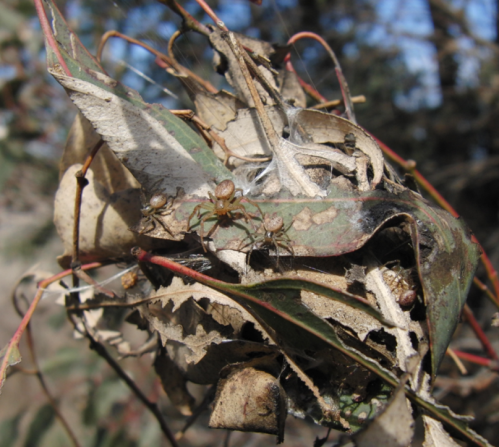How group-living spiders resolve conflicts over resources

(Phys.org) —Research has shown that group-living spiders come to peaceful arrangements for food sharing, to avoid conflict.
PhD candidate Jasmin Ruch and her co-researchers at Macquarie University and Hamburg University were interested in understanding how Australian social crab, spiders that live in large family groups of up to 80 siblings and their mother, share resources during mealtimes.
"These encounters are common among groups that hunt and feed together, but what makes this system particularly interesting is that unrelated individuals frequently join the nest and forage with the entire group," said Jasmin.
The researchers tested whether it was mostly the mother who decides who gets to feed or if the offspring themselves sort out resource sharing, perhaps even discriminating against the unrelated invaders.
They manipulated the family composition, creating groups of related siblings and groups containing unrelated individuals (mixed broods). To both groups containing siblings they added either the mother or an unrelated foster mother, while females caring for mixed broods were only related to parts of the brood.
It was found that sibling groups grew better than groups containing a mixture of related and unrelated spiderlings, indicating that siblings cooperate more, and have less conflict over food sharing. Curiously, this was true regardless of whether the caring female was a genetic or foster mother.
"We were really surprised to find that mothers did not discriminate between her own and another mother's brood' says Jasmin.
The results indicate that mothers respond to a harmonious brood, and are willing to share more prey when the brood contains siblings that cooperate rather than fight and compete, as you would expect in a group of unrelated individuals.
The full paper Offspring dynamics affect food provisioning, growth and mortality in a brood-caring spider, has been published by the journal Proceedings of the Royal Society B.
More information: "Offspring dynamics affect food provisioning, growth and mortality in a brood-caring spider." Jasmin Ruch, Marie E. Herberstein and Jutta M. Schneider. Proc. R. Soc. B March 22, 2014 281 1779 20132180; 1471-2954. DOI: 10.1098/rspb.2013.2180
Journal information: Proceedings of the Royal Society B
Provided by Macquarie University



















